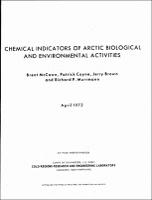Please use this identifier to cite or link to this item:
https://hdl.handle.net/11681/5921| Title: | Chemical indicators of Arctic biological and environmental activities |
| Authors: | McCown, Brent H. Coyne, Patrick I. Brown, Jerry, 1936- Murrmann, R. P. |
| Keywords: | Alaska Alaska botany Barrow, Alaska Cold regions Arctic regions Arctic botany Botany Biochemical cycles Carbon dioxide Carbon dioxide cycle Plant ecology Plant nutrition Biogeochemistry Plant-soil relationships Tundra soils EPOLAR |
| Publisher: | Cold Regions Research and Engineering Laboratory (U.S.) Engineer Research and Development Center (U.S.) |
| Series/Report no.: | Research report (Cold Regions Research and Engineering Laboratory (U.S.)) ; 301. |
| Description: | Research Report Abstract: Two approaches were used to study the carbon cycling in a cold-dominated ecosystem at Barrow, Alaska. One involved a detailed analysis of the flow of CO2 between the atmosphere, soil and biota and the other concentrated on the internal carbon cycling in plants. A pilot study was also conducted which investigated the possibility of estimating underground plant biomass by biochemical means. Both laboratory and field studies were conducted to analyze the input of CO2 to the arctic atmosphere by frozen tundra soils. Data are presented which indicate that frozen soil is a major source of CO2. It is hypothesized that CO2 trapped in soils during bi-directional freezing in the fall and winter is released during the spring thaw, thus producing a spring rise in CO2 content of the atmosphere. A procedure for the extraction and estimation of organic nutrients (lipids and carbohydrates) was developed and used to follow the seasonal cycle of these nutrients of plants obtained at Barrow, Alaska. No cycling in levels of carbohydrates (alcohol-soluble) was observed in the foliage during the season, however a definite cycling in lipid levels was seen for all the species studied. The species were synchronous. Plant survival and organic nutrient levels were followed during the winter over a heated-soil experiment at Barrow, Alaska. During the winter, the heating of the soil caused ponding which resulted in the elimination of 𝘋𝘶𝘱𝘰𝘯𝘵𝘪𝘢 𝘧𝘪𝘴𝘤𝘩𝘦𝘳𝘪 by mid-winter and the eventual death of all plants by spring. The carbohydrate levels indicated a starvation condition was created where a marked decrease in storage polymers (starch and fructans) occurred without a concurrent large increase in the alcohol-soluble carbohydrate levels. An increase in the fresh/dry weight ratios was also observed indicating etiolated, succulent growth in early winter. Four techniques were tried for estimating the below-ground biomass of plants. Two of these were eliminated as unsuitable, however two other methods(ATP and phospholipid-levels) remain to be fully evaluated. |
| Rights: | Approved for public release; distribution is unlimited. |
| URI: | http://hdl.handle.net/11681/5921 |
| Appears in Collections: | Research Report |
Files in This Item:
| File | Description | Size | Format | |
|---|---|---|---|---|
| CRREL-Research-Report-301.pdf | 1.23 MB | Adobe PDF |  View/Open |